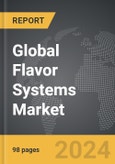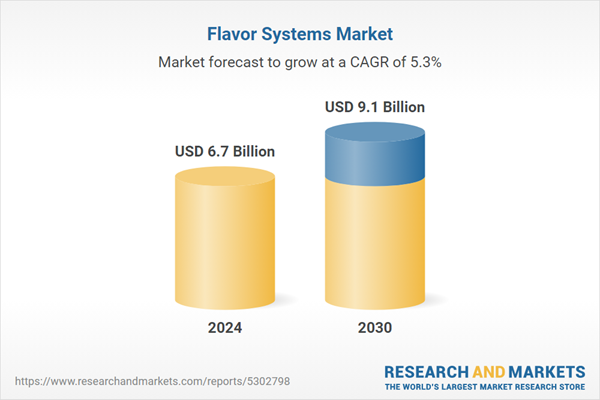The global market for Flavor Systems was estimated at US$6.7 Billion in 2024 and is projected to reach US$9.1 Billion by 2030, growing at a CAGR of 5.3% from 2024 to 2030. This comprehensive report provides an in-depth analysis of market trends, drivers, and forecasts, helping you make informed business decisions. The report includes the most recent global tariff developments and how they impact the Flavor Systems market.
Global Flavor Systems Market - Key Trends & Drivers Summarized
Why Are Flavor Systems Gaining Importance in the Food & Beverage Industry?
Flavor systems are increasingly vital to the food and beverage industry, driven by the growing demand for customized and diverse flavor profiles that cater to changing consumer tastes. These systems consist of blends of natural and artificial flavorings, essential oils, extracts, and other ingredients used to enhance the taste of food and beverages. With the rise of global culinary trends and the popularity of ethnic foods, manufacturers are investing in flavor systems to create more authentic, innovative, and appealing products. Additionally, the demand for natural and clean-label ingredients has grown, with consumers seeking food products made from natural sources rather than synthetic additives, further boosting the use of flavor systems.The increasing preference for functional foods and beverages, such as those that offer health benefits like probiotics or added vitamins, has led to the need for flavor systems that can mask undesirable tastes or enhance the sensory experience of these products. As health-conscious consumers look for products with reduced sugar, salt, or fat content, flavor systems are being employed to maintain the desired taste without compromising nutritional goals. Moreover, the growth of plant-based and alternative protein products has created a need for specialized flavor systems that can replicate traditional flavors in new formats, such as dairy-free or meat-free alternatives. This shift toward health and wellness has significantly impacted how manufacturers approach flavor development.How Is Innovation Shaping the Flavor Systems Market?
Innovation in flavor systems is a key driver of growth, as manufacturers continuously seek new ways to meet evolving consumer preferences and regulatory requirements. One area of significant innovation is the development of natural flavor systems that align with the clean-label movement. Companies are increasingly using natural extracts, essential oils, and botanical ingredients to create flavors that appeal to consumers seeking transparency and authenticity in their food choices. Additionally, advances in flavor encapsulation technology have improved the stability and shelf life of flavors, allowing for better preservation of taste over extended periods and in challenging conditions, such as high-temperature food processing.Another area of innovation is in sensory-enhancing technologies, which allow manufacturers to fine-tune the balance of sweet, salty, bitter, and savory tastes to create more complex and satisfying flavor profiles. This is particularly important in the development of reduced-sugar products, where flavor systems must replicate the full-bodied taste experience of sugar without the associated calories. Moreover, the use of artificial intelligence (AI) and data analytics in flavor creation is helping companies predict consumer preferences and develop new flavors that resonate with target audiences. AI tools are also being used to simulate how flavors interact with different ingredients, streamlining the development process and ensuring consistency across product lines.Why Are Consumer Preferences Driving Demand for Customized Flavor Systems?
The growing emphasis on personalization and tailored experiences in the food and beverage industry is a major factor driving demand for customized flavor systems. Consumers are increasingly seeking products that align with their individual tastes, dietary preferences, and cultural influences. This trend is particularly evident in categories such as beverages, snacks, and ready-to-eat meals, where flavor differentiation can be a key selling point. In response, manufacturers are turning to flavor systems to create distinct flavor profiles that cater to niche markets, such as gluten-free, vegan, or low-sugar products, while still delivering a satisfying sensory experience.The rise of experiential dining and the increasing popularity of gourmet and fusion cuisine have also contributed to the demand for more complex and layered flavors. Millennials and Generation Z, in particular, are driving this trend, as they seek out bold, adventurous flavors and are more open to trying new and exotic tastes. As a result, food and beverage companies are leveraging flavor systems to create unique, globally-inspired products that appeal to these demographics. Additionally, the trend toward sustainability and ethical sourcing is influencing flavor system development, with manufacturers increasingly incorporating organic and sustainably-sourced ingredients into their formulations.What Are the Key Factors Driving the Growth of the Flavor Systems Market?
The growth in the flavor systems market is driven by several factors, including changing consumer preferences, advancements in flavor technology, and the increasing demand for clean-label and functional foods. One of the primary drivers is the rising demand for natural and organic flavors, as consumers become more health-conscious and seek products with fewer artificial ingredients. The trend toward personalized and customized food experiences is also contributing to market growth, as manufacturers use flavor systems to create unique and tailored products that cater to diverse consumer segments.Another key growth driver is the expansion of the global food and beverage industry, particularly in emerging markets, where rising incomes and changing lifestyles are fueling demand for convenient, packaged foods. As more consumers in these regions adopt Western diets and seek out new flavors, the demand for flavor systems is expected to rise. Technological innovations, such as the development of more stable and efficient flavor encapsulation techniques, are also contributing to market growth by improving the performance of flavor systems in a wide range of food and beverage applications. Additionally, regulatory support for natural and clean-label ingredients is encouraging manufacturers to invest in the development of more transparent and sustainable flavor solutions.SCOPE OF STUDY:
The report analyzes the Flavor Systems market in terms of units by the following Segments, and Geographic Regions/Countries:- Segments: Type (Brown, Dairy, Herbs & Botanicals, Fruits & Vegetables); Application (Beverages, Dairy & Frozen Desserts, Bakery & Confectionery Products, Savories & Snacks)
- Geographic Regions/Countries: World; United States; Canada; Japan; China; Europe (France; Germany; Italy; United Kingdom; Spain; Russia; and Rest of Europe); Asia-Pacific (Australia; India; South Korea; and Rest of Asia-Pacific); Latin America (Argentina; Brazil; Mexico; and Rest of Latin America); Middle East (Iran; Israel; Saudi Arabia; United Arab Emirates; and Rest of Middle East); and Africa.
Key Insights:
- Market Growth: Understand the significant growth trajectory of the Brown segment, which is expected to reach US$3.3 Billion by 2030 with a CAGR of a 5.4%. The Dairy segment is also set to grow at 4.7% CAGR over the analysis period.
- Regional Analysis: Gain insights into the U.S. market, valued at $1.7 Billion in 2024, and China, forecasted to grow at an impressive 8.1% CAGR to reach $2.0 Billion by 2030. Discover growth trends in other key regions, including Japan, Canada, Germany, and the Asia-Pacific.
Why You Should Buy This Report:
- Detailed Market Analysis: Access a thorough analysis of the Global Flavor Systems Market, covering all major geographic regions and market segments.
- Competitive Insights: Get an overview of the competitive landscape, including the market presence of major players across different geographies.
- Future Trends and Drivers: Understand the key trends and drivers shaping the future of the Global Flavor Systems Market.
- Actionable Insights: Benefit from actionable insights that can help you identify new revenue opportunities and make strategic business decisions.
Key Questions Answered:
- How is the Global Flavor Systems Market expected to evolve by 2030?
- What are the main drivers and restraints affecting the market?
- Which market segments will grow the most over the forecast period?
- How will market shares for different regions and segments change by 2030?
- Who are the leading players in the market, and what are their prospects?
Report Features:
- Comprehensive Market Data: Independent analysis of annual sales and market forecasts in US$ Million from 2024 to 2030.
- In-Depth Regional Analysis: Detailed insights into key markets, including the U.S., China, Japan, Canada, Europe, Asia-Pacific, Latin America, Middle East, and Africa.
- Company Profiles: Coverage of players such as Firmenich, Frutarom, Givaudan, Haubao, International Flavors & Fragrances (IFF) and more.
- Complimentary Updates: Receive free report updates for one year to keep you informed of the latest market developments.
Some of the 52 companies featured in this Flavor Systems market report include:
- Firmenich
- Frutarom
- Givaudan
- Haubao
- International Flavors & Fragrances (IFF)
- Kerry Group
- Mane Sa
- Robertet
- Sensient
- Symrise
- T. Hasegawa
- Takasago
- Target Flavours, Inc.
- Tate & Lyle
- Wild
This edition integrates the latest global trade and economic shifts as of June 2025 into comprehensive market analysis. Key updates include:
- Tariff and Trade Impact: Insights into global tariff negotiations across 180+ countries, with analysis of supply chain turbulence, sourcing disruptions, and geographic realignment. Special focus on 2025 as a pivotal year for trade tensions, including updated perspectives on the Trump-era tariffs.
- Adjusted Forecasts and Analytics: Revised global and regional market forecasts through 2030, incorporating tariff effects, economic uncertainty, and structural changes in globalization. Includes segmentation by product, technology, type, material, distribution channel, application, and end-use, with historical analysis since 2015.
- Strategic Market Dynamics: Evaluation of revised market prospects, regional outlooks, and key economic indicators such as population and urbanization trends.
- Innovation & Technology Trends: Latest developments in product and process innovation, emerging technologies, and key industry drivers shaping the competitive landscape.
- Competitive Intelligence: Updated global market share estimates for 2025, competitive positioning of major players (Strong/Active/Niche/Trivial), and refined focus on leading global brands and core players.
- Expert Insight & Commentary: Strategic analysis from economists, trade experts, and domain specialists to contextualize market shifts and identify emerging opportunities.
- Complimentary Update: Buyers receive a free July 2025 update with finalized tariff impacts, new trade agreement effects, revised projections, and expanded country-level coverage.
Table of Contents
I. METHODOLOGYII. EXECUTIVE SUMMARY2. FOCUS ON SELECT PLAYERSIV. COMPETITION
1. MARKET OVERVIEW
3. MARKET TRENDS & DRIVERS
4. GLOBAL MARKET PERSPECTIVE
III. MARKET ANALYSIS
Companies Mentioned (Partial List)
A selection of companies mentioned in this report includes, but is not limited to:
- Firmenich
- Frutarom
- Givaudan
- Haubao
- International Flavors & Fragrances (IFF)
- Kerry Group
- Mane Sa
- Robertet
- Sensient
- Symrise
- T. Hasegawa
- Takasago
- Target Flavours, Inc.
- Tate & Lyle
- Wild
Table Information
| Report Attribute | Details |
|---|---|
| No. of Pages | 295 |
| Published | August 2025 |
| Forecast Period | 2024 - 2030 |
| Estimated Market Value ( USD | $ 6.7 Billion |
| Forecasted Market Value ( USD | $ 9.1 Billion |
| Compound Annual Growth Rate | 5.3% |
| Regions Covered | Global |









